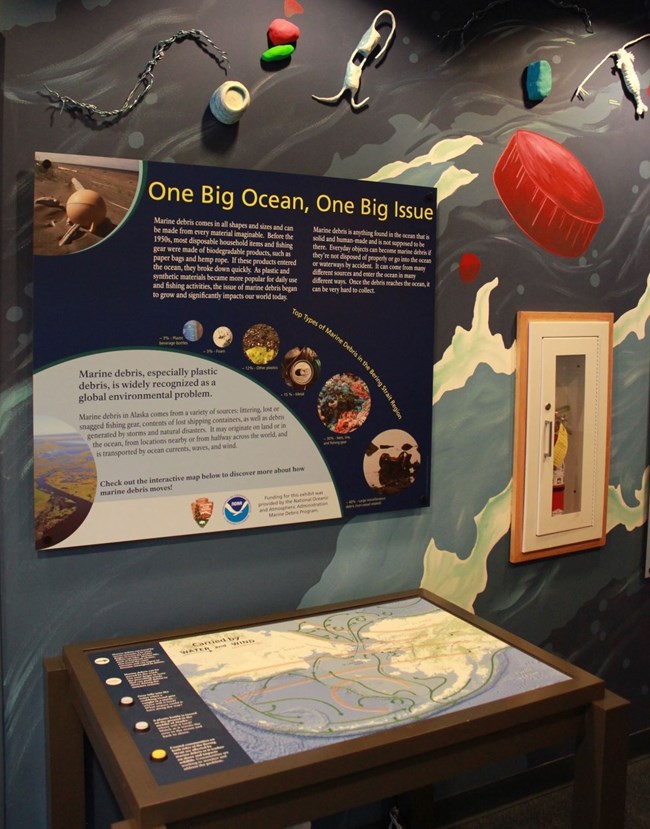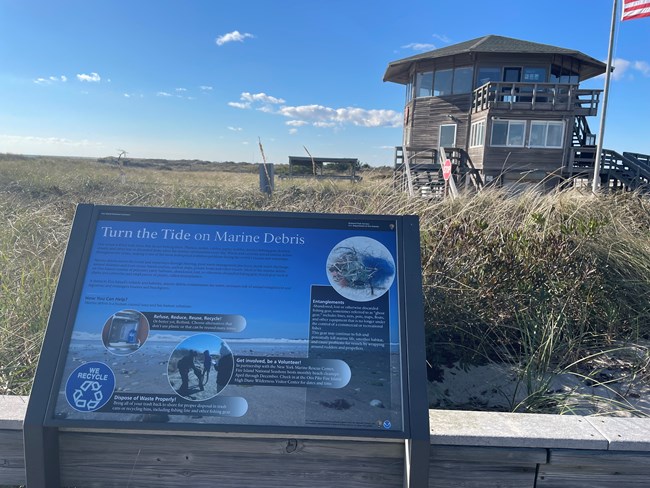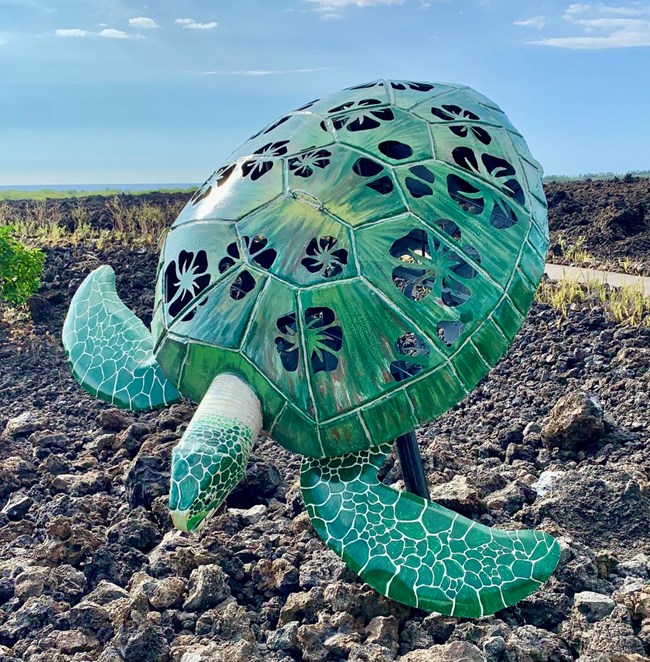The Trouble with Trash
Our oceans are filled with items that do not belong there. Huge amounts of plastics, metals, rubber, paper, textiles, derelict fishing gear, derelict vessels, and other lost or discarded items enter the marine environment every day. These items are collectively called marine debris. Winds and currents carry marine debris far distances throughout the ocean. This makes marine debris one of the most widespread pollution problems facing the world’s oceans and waterways.

NPS / Katie Hackley

NOAA Logo, NPS Logo
A Powerful Partnership
In 2020, the National Park Service teamed up with the National Oceanic and Atmospheric Administration (NOAA) Marine Debris Program to raise awareness about the sources and impacts of marine debris and to encourage individuals to take action to prevent marine debris. This five-year partnership supports the development and installation of outreach and educational exhibits in coastal national parks. Each year, three exhibits plan to be installed resulting in outreach opportunities in up to 15 parks.
Each exhibit reflects the local and regional debris issue and seeks to inspire action through engaging and interactive content. From teaming up with local artists who create sculptures that showcase local issues, to creating traveling displays that reach neighboring schools, each display is unique with its own story to tell.
Biscayne National Park
Cape Cod National Seashore
Cape Lookout National Seashore
Fire Island National Seashore
Isle Royale National Park
Kaloko-Honokōhau National Historical Park
Kenai Fjords National Park
National Park of American Samoa
New Bedford Whaling National Historical Park
Padre Island National Seashore
Perry's Victory & International Peace Memorial
More Photos of Exhibits
Marine Debris Displays in Parks
See what has been accomplished so far as a result of this powerful partnership.

NPS
One Big Ocean, One Big Issue Exhibit at Bering Land Bridge National Preserve
The marine debris exhibit at Bering Land Bridge National Preserve highlights how our oceans are all connected, and that marine debris can be transported around the world via wind and currents as well as storms and natural disasters. The exhibit, located in the visitor center, includes interpretive panels situated within a 3-D wall mural.
The exhibit also blends in interactive interpretive opportunities. There are call-to-action flip panels and an opportunity for visitors to share their ideas on reducing marine debris. The exhibit also features an interactive map table which lights up to show the path that different types of marine debris may take, highlighting predominant water currents and major communities in the area.
About the Designers:
The 3-D mural was designed and created by Elise Wahl of Timberdoodle Studio. The interactive map table was created by Color-ad inc.

NPS
An Educational Photo Op in Biscayne National Park
The marine debris display at Biscayne National Park’s Dante Fascell Visitor Center is the perfect place for a selfie to help spread the word about marine debris on social media. The display is a circular acyclic sculpture filled with marine debris that appears to be floating in the blue tinted acrylic. Along the sculpture are messages (including hashtags for sharing on social media) about marine debris and the center features a bench, perfect for photo ops. The accompanying wayside has information about marine debris in both English and Spanish, making it the first bilingual marine debris display so far.

NPS / Aleutia Scott
Marine Debris Bites at Cape Cod National Seashore
The marine debris display at Cape Cod National Seashore’s Herring Cove Bathhouse shows visitors that marine debris bites—literally! The display features a 14-foot sculpture of a white shark that is made entirely out of marine debris found along the seashore. The materials were collected by the Center for Coastal Studies’ Beach Brigade, a volunteer group of over 350 members who conducted 27 beach cleanups during 2022. Some of the most common items found during a cleanup are rope, bottle caps, fishing line and lures, straws, and plastic containers—all of which are featured in the shark sculpture.
Visitors are encouraged to spend time with the display to reflect on how they have been impacted by marine debris and what actions they can do to prevent it. The park encourages visitors to share photos of the sculpture and their actions with the hashtag #MarineDebrisBites.
About the Artist:
The creator of the shark sculpture, Cindy Pease Roe, has close ties to Cape Cod, her childhood home. Her love of the ocean and memories of the healthy ecosystem she grew up in raised concerns about the debris she was finding as she strolled along the coastline. This made her question where it came from and how it got there. After educating herself on the issue of marine debris, she became passionate about sharing this knowledge with others. About seven years ago, Cindy founded a company called UpSculpt, a combination of upcycling and sculpture. Through this non-profit, Cindy and her team use art to educate people about the impacts of marine debris and encourage the reuse of household items. She says of her projects, “It is the ultimate upcycle – you are creating something of value that didn’t have value before.”

NPS
My Clean Ocean Display at Cape Lookout National Seashore
The marine debris display at Cape Lookout National Seashore focuses on a “My Clean Ocean” campaign to help reduce the amount of plastic in the marine environment and inspire the public to choose more environmentally friendly choices when making decisions.
The metal dolphin sculpture on Cape Lookout National Seashore’s boardwalk serves as a visual reminder of the negative impacts that human-made debris has on ocean life. The dolphin is hollow, allowing park staff to fill it with marine debris discovered during one their many beach cleanup volunteer opportunities. Although all kinds of things are found along the seashore during a beach cleanup, objects like rope, fishing line and plastic containers end up taking up the bulk of the space in the sculpture. Visitors are encouraged to pledge their support for keeping the ocean clean.
About the Artist:
The metal dolphin sculpture was commissioned by local Jacksonville, North Carolina artist Steve Zawistowski of Stephen Z Metal Designs Inc.. Steve takes pride in “making pieces that do not replicate nature but reflect its essence.”

NPS
Turn the Tide on Marine Debris at Fire Island National Seashore
The marine debris display at Fire Island National Seashore is made up of multiple components and waysides that are located throughout the park. At the Otis Pike Wilderness Visitor Center, a workstation is set up with several microscopes so visitors will have the opportunity to search for microplastics in sand collected from Fire Island beaches. At Watch Hill, visitors can view an osprey and nest sculpture. The nest is made entirely of materials like plastic marine debris and a boat piling that were recovered from an actual osprey nest that had been toppled. Waysides can be found near the Fire Island Lighthouse, at the Otis Pike Wilderness Visitor Center, and at Watch Hill.About the Artist:
Cindy Pease Roe created the osprey and nest sculpture through her role as founder of UpSculpt. Park staff collaborated with the NOAA Marine Debris Program and the NPS Ocean and Coastal Resources Program to create the wayside displays and workstation exhibits.
NPS
Support Superior at Isle Royale National Park
The exhibit includes a display at the Rock Harbor Auditorium at Isle Royale National Park (ISRO). The Rock Harbor display includes artistic creations using marine debris, a cabinet of curiosities filled with items collected along the Lake Superior shoreline, and an interactive poetry station. There are also two informational panels on the Ranger III ferry (the ferry that brings visitors from Houghton, MI to ISRO) that highlight why marine debris is a problem and what visitors can do about the issue. See the press release for more information.
About the Artist:
Mariah Reading is an eco-artist who designed and curated the exhibit. She is a strong advocate of National Parks.Adrienne Wallner and David Mainero contributed to the exhibit.

NPS
The Trouble with Trash at Kaloko-Honokōhau National Historical Park
The marine debris display at Kaloko-Honokōhau National Historical Park focuses on wildlife entanglement in marine debris, especially the beloved and endangered honu, or Hawaiian sea turtle.
The display features a large metal sea turtle that is filled with marine debris from beach clean-ups. The wayside encourages visitors to learn from traditional Hawaiian practices and mālama (care for) the ocean through a shared kuleana (responsibility) to practice responsible fishing to maintain the health of the park in balance with people as it has for generations.
In addition to the sculpture and wayside, the park has also installed fishing line collection bins and developed a portable educational kit for rangers to use in their marine debris interpretive programs.
About the Artist:
The honu sculpture was commissioned by Jim Swaim of Environment Sculptures. Jim creates marine debris sculptures which have been displayed around the world.

NPS
Talking Trash at Kenai Fjords National Park
The exhibit at Kenai Fjords National Park’s visitor center highlights how some of the most heavily polluted beaches in the park are, surprisingly, also some of the most remote. Marine debris along the park’s coastline is both domestic and industrial, as well as post-tsunami debris. In 2009, staff, volunteers, and partners removed about nineteen tons of marine debris from coastal habitats! Yet, to truly turn the tide on marine debris, this exhibit shows that we need to prevent it from entering the ocean in the first place.
The exhibit consists of two parts. The first part is a mural exploring the connection between coastal fjord estuaries and marine debris. The mural is a beautiful addition to the existing humpback whale sculpture outside of the newly renovated visitor center. The second part of the exhibit is a mobile display that engages visitors in audience-centered interpretive experiences that empower visitors to take a deeper dive into the marine debris issue through a series of questions, challenges, pledges, and games.
About the Artist:
The mural in the exhibit was designed by Jane Kim of Ink Dwell, a studio that “creates art that explore the beauty and complexity of nature.” Jane is a visual artist and science illustrator that has created large scale public art across the country.

NPS
Underwater Mural at National Park of American Samoa
The marine debris display at National Park of American Samoa features a hand-painted mural of an underwater scene in a classroom inside the park’s visitor center. The mural features pieces of marine debris scattered throughout the beautiful scenery of ocean life in American Samoa. The visuals are accompanied by lighting effects and ocean sounds, which create an immersive experience for visitors. Through an educational scavenger hunt, visitors can search for the pieces of marine debris in the mural. In addition to the scavenger hunt, visitors can interact with the exhibit by answering a marine debris question posed on a white board. They can also read a large interpretive panel with information on marine debris in both Samoan and English.
About the Artist:
Reggie Meredith, an American Samoan artist and academic, created the mural. She is well-known for creating paintings and barkcloth textile art, also known as siapo.

NPS
"The Water We’re Swimming In" at New Bedford Whaling National Historical Park
The Water We’re Swimming In, a sculpture created by artist Elaine Alder made of marine debris collected off the coast of Massachusetts, is displayed in Captain Paul Cuffe Park at the New Bedford Whaling Museum, New Bedford, MA. This sculpture uses worn-out tires, steel, and fishing rope to display whales breaching and playing in the water. The display is the result of a partnership between New Bedford Whaling National Historical Park, New Bedford Whaling Museum, NPS Ocean and Coastal Resources Program, and NOAA Marine Debris Program.About the Artist:
Elaine Alder is the artist-in-residence at the New Bedford Whaling National Historical Park. Their art spans multiple types of media including ceramics and textiles and is inspired by nature.

NPS
Interactive Plinko Game at Padre Island National Seashore
The exhibit at Padre Island National Seashore is centered around an interactive Plinko game, prompting visitors to think about the origins of marine debris and realize that the best way to reduce marine debris is to prevent its introduction into the system. The game is paired with educational panels that describe what marine debris is, where it comes from, and how it affects local marine life. The exhibit is located at the Malaquite Visitor Center.
The park also has a traveling display composed of a portable Plinko game and informational banners that are replicas of the panels displayed in the visitor center. The traveling display can be brought to schools and off-site educational events around the community.
About the Artist:
Park staff created this marine debris display in collaboration with Nora Pinell-Hernandez. She is the founder of Atomic Carrots, which is an exhibit design and fabrication shop based in Oakland Park, Florida. Since May 2019, Atomic Carrots has designed and fabricated dozens of interactive, interpretive panels and exhibits for museums and national parks.

NPS
Mobile Marine Debris Exhibit at Perry’s Victory & International Peace Memorial
Marine debris affects the Great Lakes too! The portable display at Perry’s Victory & International Peace Memorial brings the outreach on the road, highlighting the issues and impacts of marine debris on Lake Erie. This display consists of six retractable banners, a handout for kids, a pledge to protect Lake Erie, and a diorama with audio narration.
See the full text and hear the narrations of the exhibit.
Last updated: August 11, 2025
